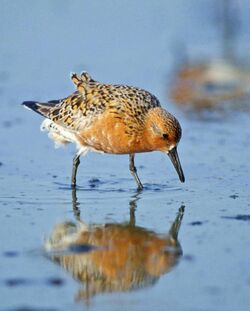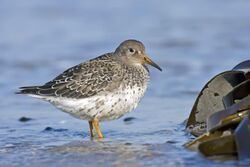Biology:Calidrid
| Typical waders | |
|---|---|

| |
| Red knot, Calidris canutus. Calidris s.str. are stout birds with bold pattern in breeding plumage | |
| Scientific classification | |
| Kingdom: | Animalia
|
| Phylum: | |
| Class: | |
| Order: | |
| Family: | Scolopacidae (partim)
|
| Genera | |
|
Calidris | |
The calidrids or typical waders are a group of Arctic-breeding, strongly migratory wading birds. These birds form huge mixed flocks on coasts and estuaries in winter. They are the typical "sandpipers", small to medium-sized, long-winged and relatively short-billed.
Their bills have sensitive tips which contain numerous Corpuscles of Herbst, enabling the birds to locate buried prey items, which they typically seek with restless running and probing.[1]
As some calidrids share the common name "sandpiper" with more distantly related birds such as the Actitis species, the term stint is preferred in Britain for the smaller species of this group.
Systematics and taxonomy
The calidrids' closest relatives are the two species of turnstone, and if the calidrids were to be considered one or two tribes Calidriini and/or Arenariini, and/or subfamily Eroliinae, the turnstones would be included in it.[2] A fossil bone, a distal piece of tarsometatarsus, was found in the Edson Beds of Sherman County, Kansas. Dating from the mid-Blancan some 3-4 million years ago, it appears to be from a calidrid somewhat similar to a pectoral sandpiper, but has some traits reminiscent of turnstones.[3] Depending on which traits are apomorphic and plesiomorphic, it may be an ancestral representative of either lineage. It might also belong to some distinct prehistoric genus, as true calidriid sandpipers seem to have been present earlier (see below).
The interrelationships of the calidrid group are not altogether well resolved. Several former genera have been included in Calidris, such as the stilt sandpiper (previously Micropalama himantopus)[citation needed], but the new placement was also not entirely satisfactory. It was suggested, for example, that the sanderling should be placed into a monotypic genus Crocethia,[4] and the other small Calidris species separated as Erolia[citation needed]. Alternatively, it was suggested that the monotypic Aphriza, Limicola and Eurynorhynchus be also merged into Calidris.
A comprehensive analysis in 2004 – based on newly available DNA sequence data[2] – indicated that the extended Calidris is indeed paraphyletic (or polyphyletic if all calidrids are combined in it), but found the present DNA sequence data insufficient to resolve the relationships of some more unusual taxa such as the curlew sandpiper. In addition, it is known that the calidriid lineages are able to hybridize to a considerable extent and in the past, this was probably even more frequent and more hybrids would have been viable; therefore studies based on mtDNA data alone can be unreliable.
Genera and species
The species, according to the 2017 I.O.C. assessment,[5] are as follows:

This species seems to belong to a small divergent radiation
- Genus Calidris
- Surfbird, Calidris virgata
- Great knot, Calidris tenuirostris
- Red knot, Calidris canutus
- Sanderling, Calidris alba
- Semipalmated sandpiper, Calidris pusilla
- Western sandpiper, Calidris mauri
- Red-necked stint, Calidris ruficollis
- Little stint, Calidris minuta
- Temminck's stint, Calidris temminckii
- Long-toed stint, Calidris subminuta
- Least sandpiper, Calidris minutilla
- White-rumped sandpiper, Calidris fuscicollis
- Baird's sandpiper, Calidris bairdii
- Pectoral sandpiper, Calidris melanotos
- Sharp-tailed sandpiper, Calidris acuminata
- Curlew sandpiper, Calidris ferruginea
- Purple sandpiper, Calidris maritima
- Rock sandpiper, Calidris ptilocnemis
- Dunlin, Calidris alpina
- Stilt sandpiper, Calidris himantopus
- Spoon-billed sandpiper, Calidris pygmeus
- Broad-billed sandpiper, Calidris falcinellus
- Buff-breasted sandpiper, Calidris subruficollis
- Ruff, Calidris pugnax
As mentioned above, there exists some material of birds essentially identical to calidrid sandpipers from before the Pleistocene. An undescribed species is known from the Early Miocene of Dolnice (Czech Republic). Tringa gracilis (Early Miocene of WC Europe) and Tringa minor (= Totanus minor, Erolia ennouchii) from the Middle Miocene of Grive-Saint-Alban (France) are scolopacids of rather uncertain affiliations; they might be charadriids.[6]
See also
References
- ↑ Nebel, S.; Jackson, D.L.; Elner, R.W. (2005). "Functional association of bill morphology and foraging behaviour in calidrid sandpipers". Animal Biology 55 (3): 235–243. doi:10.1163/1570756054472818. Archived from the original on 2011-06-10. https://web.archive.org/web/20110610081512/http://publish.uwo.ca/~snebel2/nebel05AnimBiol.pdf.
- ↑ 2.0 2.1 Thomas, Gavin H.; Wills, Matthew A.; Székely, Tamás (2004). "A supertree approach to shorebird phylogeny". BMC Evolutionary Biology 4: 28. doi:10.1186/1471-2148-4-28. PMID 15329156. Supplementary Material[yes|permanent dead link|dead link}}]
- ↑ Wetmore, Alexander (1937). "The Eared Grebe and other Birds from the Pliocene of Kansas". Condor 39 (1): 40. doi:10.2307/1363487. http://sora.unm.edu/sites/default/files/journals/condor/v039n01/p0040-p0040.pdf.
- ↑ Macwhirter, Bruce; Peter Austin-Smith Jr. (2002). "Sanderling (Calidris alba)". in A. Poole. The Birds of North America Online. Cornell Lab of Ornithology. http://bna.birds.cornell.edu/bna/species/653/articles/systematics. Retrieved 16 April 2011.
- ↑ "buttonquail, plovers, seedsnipe & sandpipers". International Ornithological Congress. http://www.worldbirdnames.org/bow/buttonquail/.
- ↑ Mlíkovský, Jirí (2002): Cenozoic Birds of the World, Part 1: Europe. Ninox Press, Prague.
External links
- RedKnot.org links to shorebird recovery sites, movies, events and other information on red knot rufa and horseshoe crabs.



